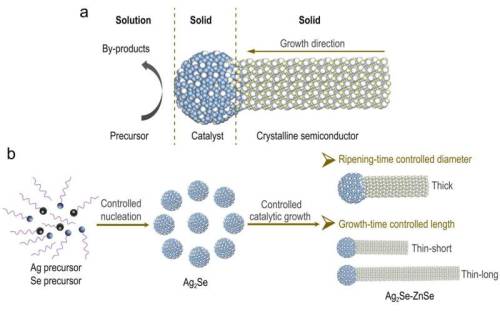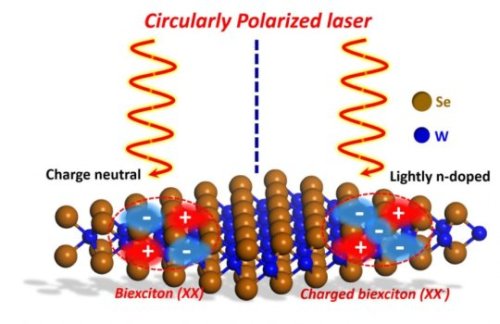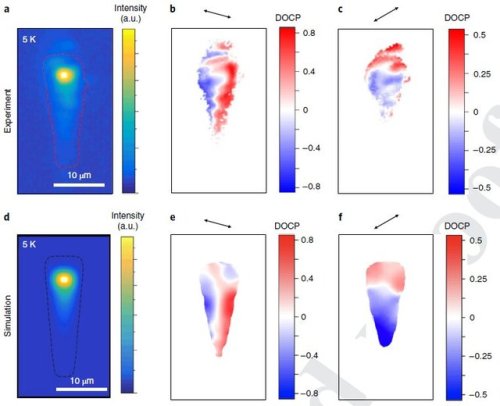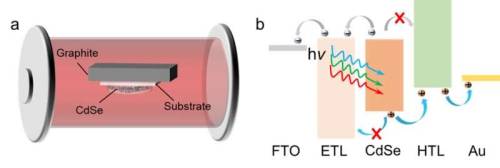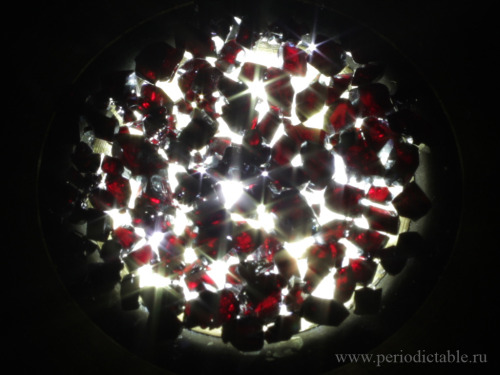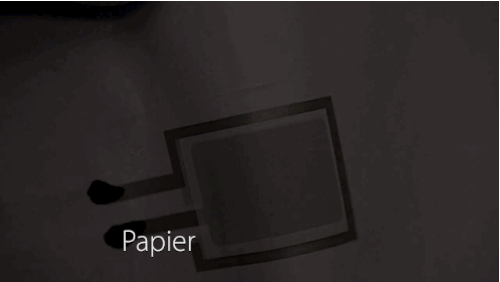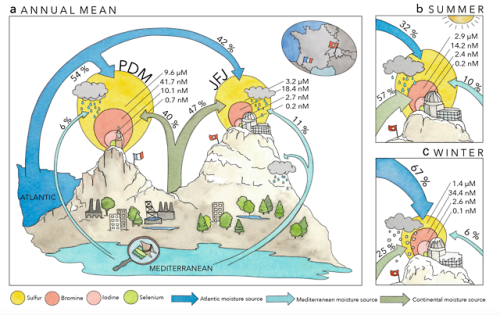#selenium
Copper ions flow like liquid through crystalline structures
Materials scientists have sussed out the physical phenomenon underlying the promising electrical properties of a class of materials called superionic crystals. A better understanding of such materials could lead to safer and more efficient rechargeable batteries than the current standard-bearer of lithium ion.
Becoming a popular topic of study only within the past five years, superionic crystals are a cross between a liquid and a solid. While some of their molecular components retain a rigid crystalline structure, others become liquid-like above a certain temperature, and are able to flow through the solid scaffold.
In a new study, scientists from Duke University, Oak Ridge National Laboratory (ORNL) and Argonne National Laboratory (ANL) probed one such superionic crystal containing copper, chromium and selenium (CuCrSe2) with neutrons and X-rays to determine how the material’s copper ions achieve their liquid-like properties. The results appear online on Oct. 8 in the journal Nature Physics.
“When CuCrSe2 is heated above 190 degrees Fahrenheit, its copper ions fly around inside the layers of chromium and selenium about as fast as liquid water molecules move,” said Olivier Delaire, associate professor of mechanical engineering and materials science at Duke and senior author on the study. “And yet, it’s still a solid that you could hold in your hand. We wanted to understand the molecular physics behind this phenomenon.”
Post link
A pathway to high-quality ZnSe quantum wires
One-dimensional semiconductor nanowires with strong quantum confinement effect—quantum wires (QWs)—are of great interest for applications in advanced optoelectronics and photochemical conversions. Beyond the state-of-the-art Cd-containing ones, ZnSe QWs, as a representative heavy-metal-free semiconductor, have shown the utmost potential for next-generation environmental-friendly applications.
Unfortunately, ZnSe nanowires produced thus far are largely limited to the strong quantum confinement regime with near-violet-light absorption or to the bulk regime with undiscernible exciton features. Simultaneous, on-demand, and high-precision manipulations on their radial and axial sizes—that allows strong quantum confinement in the blue-light region—has so far been challenging, which substantially impedes their further applications.
In a new article published in the National Science Review, a research team led by professor YU Shuhong at University of Science and Technology of China (USTC) has reported the on-demand synthesis of high-quality, blue-light-active ZnSe QWs by developing a flexible synthetic approach—a two-step catalytic growth strategy that enables independent, high-precision, and wide-range controls over the diameter and length of ZnSe QWs. In this way, they bridge the gap between prior magic-sized ZnSe QWs and bulk-like ZnSe nanowires.
Post link
Research on light-matter interaction could improve electronic and optoelectronic devices
Fundamental research sheds light on new many-particle quantum physics in atomically thin semiconductors
A paper published in Nature Communications by Sufei Shi, assistant professor of chemical and biological engineering at Rensselaer, increases our understanding of how light interacts with atomically thin semiconductors and creates unique excitonic complex particles, multiple electrons, and holes strongly bound together. These particles possess a new quantum degree of freedom, called “valley spin.” The “valley spin” is similar to the spin of electrons, which has been extensively used in information storage such as hard drives and is also a promising candidate for quantum computing.
The paper, titled “Revealing the biexciton and trion-exciton complexes in BN encapsulated WSe2,” was published in the Sept. 13, 2018, edition of Nature Communications. Results of this research could lead to novel applications in electronic and optoelectronic devices, such as solar energy harvesting, new types of lasers, and quantum sensing.
Shi’s research focuses on low dimensional quantum materials and their quantum effects, with a particular interest in materials with strong light-matter interactions. These materials include graphene, transitional metal dichacogenides (TMDs), such as tungsten diselenide (WSe2), and topological insulators.
Post link
Physicists have let light through the plane of the world’s thinnest semiconductor crystal
In every modern microcircuit hidden inside a laptop or smartphone, you can see transistors—small semiconductor devices that control the flow of electric current, i.e. the flow of electrons. If we replace electrons with photons (elementary particles of light), then scientists will have the prospect of creating new computing systems that can process massive information flows at a speed close to the speed of light. At present, it is photons that are considered the best for transmitting information in quantum computers. These are still hypothetical computers that live according to the laws of the quantum world and are able to solve some problems more efficiently than the most powerful supercomputers.
Although there are no fundamental limits for creating quantum computers, scientists still have not chosen what material platform will be the most convenient and effective for implementing the idea of a quantum computer. Superconducting circuits, cold atoms, ions, defects in diamond and other systems now compete for being one chosen for the future quantum computer. It has become possible to put forward the semiconductor platform and two-dimensional crystals, specifically, thanks to scientists from: the University of Würzburg (Germany); the University of Southampton (United Kingdom); the University of Grenoble Alpes (France); the University of Arizona (USA); the Westlake university (China), the Ioffe Physical Technical Institute of the Russian Academy of Sciences; and St Petersburg University.
Post link
Iron selenide film reveals clues about superconductivity
Through their study of two-dimensional iron selenide (FeSe) films, a research team has unlocked some intriguing clues about superconductivity.
Superconductors—materials that can transport electrons with no resistance—are a quantum phenomenon with numerous applications. They have fascinated physicists and engineers since their discovery more than 100 years ago, but the mechanisms of modern superconductors are still not fully understood and remain one of the most active areas of research in quantum materials.
Since it was discovered in 2012, FeSe in its three-atoms-thick monolayer form has received much attention from researchers for its unusual superconductive properties. In bulk form, it becomes a superconductor at 8 Kelvin, or -265 Celsius. As a monolayer, though, it starts superconducting at about 70 Kelvin, or 203 degrees below zero—still very chilly, but moving in the right direction. In a collaboration with the University of British Columbia, Yale researchers shed some light on behavior of electrons in this system, which could prove to be key to understanding superconductivity itself. The results are published in Nature Communications.
Post link
Turning heat energy into a viable fuel source
A new device being developed by Washington State University physicist Yi Gu could one day turn the heat generated by a wide array of electronics into a usable fuel source.
The device is a multicomponent, multilayered composite material called a van der Waals Schottky diode. It converts heat into electricity up to three times more efficiently than silicon – a semiconductor material widely used in the electronics industry. While still in an early stage of development, the new diode could eventually provide an extra source of power for everything from smartphones to automobiles.
“The ability of our diode to convert heat into electricity is very large compared to other bulk materials currently used in electronics,” said Gu, an associate professor in WSU’s Department of Physics and Astronomy. “In the future, one layer could be attached to something hot like a car exhaust or a computer motor and another to a surface at room temperature. The diode would then use the heat differential between the two surfaces to create an electric current that could be stored in a battery and used when needed.”
Gu recently published a paper on the Schottky diode in The Journal of Physical Chemistry Letters.
Post link
Rapid preparation of CdSe thin-film solar cells
The silicon-based tandem solar cell is regarded as the most promising strategy to break the theoretical efficiency limit of single-junction Si solar cells. With Si-based tandem solar cells as the bottom cells, the optimal bandgap of top cells is 1.7 eV, which enables high efficiency of ~45% for two-junction tandem solar cells. III-V semiconductors/Si and perovskites/Si tandem solar cells have achieved high efficiency levels of ~30%, proving their feasibility. However, the stability challenges of perovskite and the high-cost problem of III-V semiconductors largely limit their wide applications. Exploring new stable, low-cost, and bandgap 1.7 eV photovoltaic materials is of great significance in science and broad prospects in technology.
Cadmium selenide (CdSe), a binary II-VI semiconductor, enjoys great potential in the application of Si-based tandemsolar cells because of the suitable bandgap of ~1.7 eV, excellent optoelectronic properties, high stability, and low manufacturing cost. Nevertheless, the progress of CdSe thin-film solar cells remains as it was 30 years ago, and there are few systematic studies on CdSe thin-film solar cells in recent years.
Professor Tang Jiang and his team have proposed a method of rapid thermal evaporation (RTE) to obtain high-quality CdSe thin films and have designed CdSe thin-film solar cells. This study, entitled Rapid thermal evaporation for cadmium selenide thin-film solar cells, was published in Frontiers of Optoelectronics on Dec. 6, 2021.
Post link
Discovered in 1817 by Jöns Jakob Berzelius and Johan Gottlieb Gahn, selenium was initially assumed to be a tellurium compound. When Berzelius reanalyzed his sample he ended up naming the new element for the Greek word selene, meaning moon, since it was so similar to tellurium, named for the Earth.

Selenium is the thirty fourth element, consisting of thirty four protons and electrons. A rare element, it is mostly found as impurities in various minerals, primarily as a replacement for sulfur.
On the periodic table, it is classified as a nonmetal. A nonmetal is typically highly volatile, with low elasticity, and good insulation for both heat and electricity. Despite the number of metals versus nonmetals, living organisms are composed almost entirely of nonmetals and nonmetals form more compounds than metals.
Like sulfur above it, selenium has many allotropes, some of which take cyclic, or ring-shaped forms. Selenium has six naturally occurring isotopes, only one of which is not stable.
SELENIUM
Monoclinic selenium crystals appear charcoal-gray (left), but when light is shined through them, they transmit a deep red hue (right). Glassmakers use selenium to add red to their creations, whereas dandruff shampoos use it for its antifungal action. The element is also an essential micronutrient, used in several enzymes where it is usually held in place by the amino acid cysteine.
Credit:www.periodictable.ru
Post link
Glowing Paper & Clear Film Bring Flexible Electronics Closer
Light-emitting paper and film have been created in China and Germany, signalling another advance of flexible electronics that will one day be worn on the sleeve or folded up and stuffed in a pocket.
At the Karlsruhe Institute of Technology, engineers have improved on the process of making a material called electroluminescent foil, which glows when current flows through it. They say they can now directly print electroluminescent layers onto other materials like paper and plastic. Their pad-printing process can even be used to layer the film onto convex, concave or other three-dimensional surfaces.
“Any type of three-dimensional object can be provided with electroluminescent coatings at low costs,” said Rainer Kling, a senior scientist at KIT’s Light Technology Institute.
Post link
Controlling heat flow in a solid by switching crystal structure dimensionality
Just as an electrical switch regulates the flow of electric current, thermal switches can control the flow of heat. These switches serve as thermal control devices and are useful for thermal management applications. For example, they can be used in industries to reduce waste heat, resulting in cost and energy savings. These switches require materials whose thermal conductivity (κ) can be modulated to a large extent. This would allow the switch to have an “on” and “off” state depending on the thermal conductivity. However, such materials are rare and challenging to develop, and those that have been developed show only small reversible variations in their κ.
Now, in a study published in Advanced Electronic Materials, researchers from Tokyo Institute of Technology (Tokyo Tech) and the National Institute for Materials Science, Japan, have taken things to the next level with a material that can achieve a large variation in its κ by changing its crystal structure dimensionality. The team achieved this remarkable feat by using a solid solution of lead selenide (PbSe) and tin selenide (SnSe), which can switch between a 3-dimensional (3D) cubic crystal structure and a 2-dimensional (2D) layered crystal structure with changes in temperature.
Post link
Site : Morn Hill, Winchester. by Russell Moreton
Via Flickr:
Pinhole photography, liquid light emulsion, selenium toner.
Did you know that selenium deficiency is a thing?
Up to a billion people around the globe are deficient, not getting enough of this trace element from their diet. This is why we are interested in understanding what controls selenium levels in soils. The atmosphere supplies Se to the soil environment - but where does this initially come from? I loved illustrating this study by Süss et al., (2019), investigating trace element sources using rainwater analyses. The data show that the terrestrial biosphere apparently has much more of an impact than we traditionally thought - at least during the summer.
source:
Elke Suess, Franziska Aemisegger, Jeroen E. Sonke, Michael Sprenger, Heini Wernli and Lenny H. E. Winkel (2019): Marine versus continental sources of iodine and selenium in rainfall at two European high-altitude locations. Environmental Science & Technology. DOI: 10.1021/acs.est.8b05533
Post link
Silvery hairs of Native Selenium on Coal matrix
Locality: Kladno Mine, Libušin, Kladno, Central Bohemian Region, Czech Republic
Post link
Re-teaching myself Selenium because I keep forgetting because I never use it because I’m stuck using HP tools at work. It’s so much ball ache just getting it set up, but Java is a much nicer language than VB.
Gonna spend the weekend automating browser based games for practice. If anybody’s got any good ones let me know and I’ll return the favour by sending you my code so you can essentially bot the game… not that I’m condoning that.


